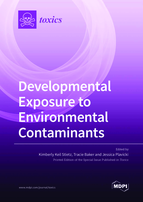Developmental Exposure to Environmental Contaminants
A special issue of Toxics (ISSN 2305-6304). This special issue belongs to the section "Reproductive and Developmental Toxicity".
Deadline for manuscript submissions: closed (30 June 2022) | Viewed by 39493
Special Issue Editors
Interests: polychlorinated biphenyls; developmental neurotoxicology; impact of environmental contaminants on lower urinary tract development; structure and function
Interests: developmental and reproductive toxicology; emerging contaminants; epigenetic inheritance; adult onset and transgenerational disease; endocrine disrupting chemicals
Special Issue Information
Dear Colleagues,
Development provides an especially sensitive window whereby environmental contaminants can have significant and lasting effects on the morphology and function of many organs and systems. The importance of understanding developmental effects of environmental contaminants extends not only to developmental stages, but also to encompass the hypotheses of the developmental or fetal origins of adult disease. Such effects of environmental contaminants during development extend to health outcomes that can persist in adulthood, first become apparent in adulthood, or manifest in adulthood but only after a second hit/stressor. The diverse nature of possible environmental contaminants, ranging from persistent organic pollutants such as polychlorinated biphenyls (PCBs) to emerging contaminants of concern such as Per- and polyfluoroalkyl substances (PFAS), along with the diverse range of health implications including autism, diabetes, cancer, infertility, and lower urinary tract function make understanding developmental effects of environmental contaminants an ever growing and important field of study.
We are pleased to invite you to contribute to this Special Issue which aims to explore a variety of topics in line with the aims and scope of Toxics. Specifically, topics related to the developmental effects of environmental contaminants and/or their metabolites on the molecular, cellular, tissue, organ, organ system or organism, including mechanisms of toxicity, metabolism, risk assessment and management, as well as multiple stressor impacts in the context of aging or disease progression following developmental exposures.
In this Special Issue, original research articles and reviews are welcome. Research areas may include, but is not limited to the following: developmental effects of environmental exposures using in vitro, ex vivo, or in vivo models, and fetal origins of adult disease models. This Special Issue may include developmental effects of emerging contaminants of concern, mixtures, metals, pesticides/herbicides, persistent organic pollutants, or particulate matter, to name a few.
We look forward to receiving your contributions.
Dr. Kimberly Keil Stietz
Dr. Tracie Baker
Dr. Jessica Plavicki
Guest Editors
Manuscript Submission Information
Manuscripts should be submitted online at www.mdpi.com by registering and logging in to this website. Once you are registered, click here to go to the submission form. Manuscripts can be submitted until the deadline. All submissions that pass pre-check are peer-reviewed. Accepted papers will be published continuously in the journal (as soon as accepted) and will be listed together on the special issue website. Research articles, review articles as well as short communications are invited. For planned papers, a title and short abstract (about 100 words) can be sent to the Editorial Office for announcement on this website.
Submitted manuscripts should not have been published previously, nor be under consideration for publication elsewhere (except conference proceedings papers). All manuscripts are thoroughly refereed through a single-blind peer-review process. A guide for authors and other relevant information for submission of manuscripts is available on the Instructions for Authors page. Toxics is an international peer-reviewed open access monthly journal published by MDPI.
Please visit the Instructions for Authors page before submitting a manuscript. The Article Processing Charge (APC) for publication in this open access journal is 2600 CHF (Swiss Francs). Submitted papers should be well formatted and use good English. Authors may use MDPI's English editing service prior to publication or during author revisions.
Keywords
- fetal origins of adult disease
- developmental toxicity
- contaminants of emerging concern
- PCBs
- PFAS
- persistent organic pollutants
- metals
- mixtures
- pesticides









